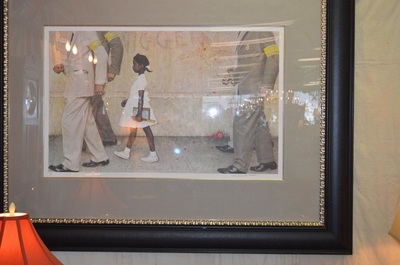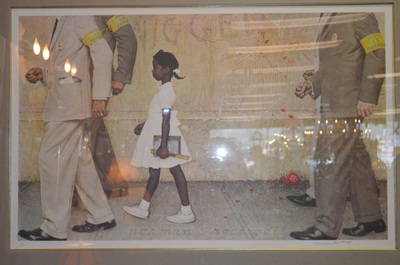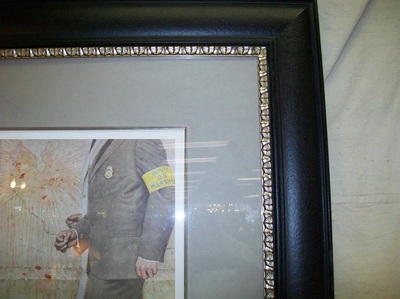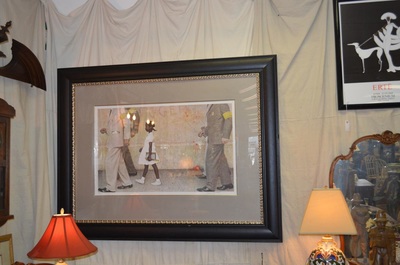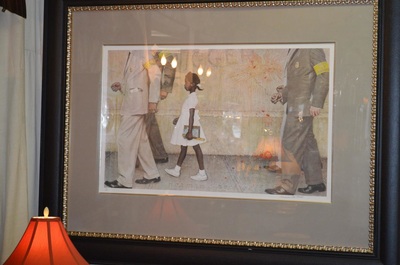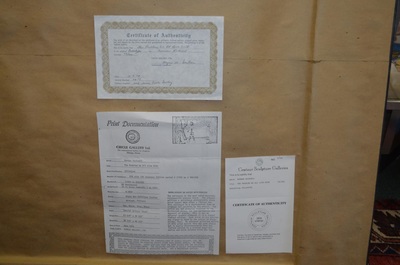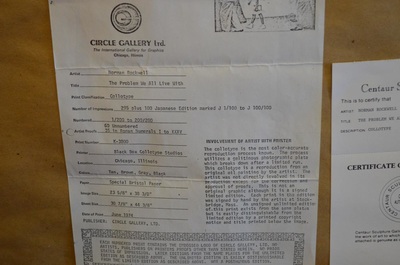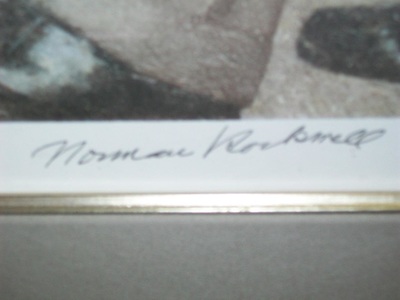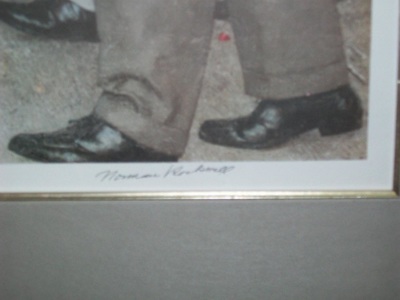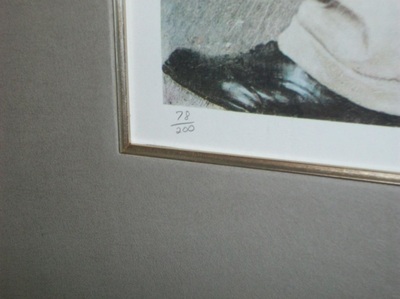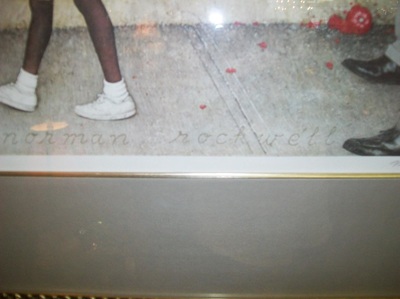Norman Perceval Rockwell (February 3, 1894 – November 8, 1978) was a 20th-century American painter and illustrator. His works enjoy a broad popular appeal in the United States for their reflection of American culture.
The Problem We All Live With is a 1964 painting by Norman Rockwell. An iconic image of the civil rights movement in the United States, it depicts Ruby Bridges, a six-year-old African-American girl, on her way into an all-white public school in New Orleans on November 14, 1960 during the process of racial desegregation. Because of threats and violence against her, she is escorted by four deputy U.S. marshals; the painting is framed such that the marshals' heads are cropped at the shoulders. On the wall behind her is written the racial slur "nigger" and the letters "KKK"; a smashed tomato thrown at Bridges is also visible. The white crowd is not visible, as the viewer is looking at the scene from their point of view.The painting is oil on canvas and measures 36 inches high by 58 inches wide.
The painting was originally published as a centerfold in the January 14, 1964 issue of Look.Rockwell had ended his contract with the Saturday Evening Post the previous year due to frustration with the limits the magazine placed on his expression of political themes, and Look offered him a forum for his progressive social interests, including civil rights and racial integration. Rockwell explored similar themes in Southern Justice (Murder in Mississippi) and New Kids in the Neighborhood; unlike his previous works for the Post, The Problem We All Live With and these others place black people as sole protagonists, instead of as observers, part of group scenes, or in servile roles. Like New Kids in the Neighborhood, The Problem We All Live With depicts a black child protagonist; like Southern Justice, it uses strong light-dark contrasts to further its racial theme.
At Bridges' suggestion, President Barack Obama had the painting installed in the White House, in a hallway outside the Oval Office, from July to October 2011. Art historian William Kloss stated, "The N-word there – it sure stops you. There’s a realistic reason for having the graffiti as a slur, [but] it’s also right in the middle of the painting.
Colors: Tan, Brown, Gray, Black
Paper: Special Bristol Paper
Image Size: 23 5/8" x 38 3/8"
Sheet size: 30 7/8" x 44 3/8"
Framed Size: 63" x 49"
number 78 of 200
Date of Print: June 1974
The Problem We All Live With is a 1964 painting by Norman Rockwell. An iconic image of the civil rights movement in the United States, it depicts Ruby Bridges, a six-year-old African-American girl, on her way into an all-white public school in New Orleans on November 14, 1960 during the process of racial desegregation. Because of threats and violence against her, she is escorted by four deputy U.S. marshals; the painting is framed such that the marshals' heads are cropped at the shoulders. On the wall behind her is written the racial slur "nigger" and the letters "KKK"; a smashed tomato thrown at Bridges is also visible. The white crowd is not visible, as the viewer is looking at the scene from their point of view.The painting is oil on canvas and measures 36 inches high by 58 inches wide.
The painting was originally published as a centerfold in the January 14, 1964 issue of Look.Rockwell had ended his contract with the Saturday Evening Post the previous year due to frustration with the limits the magazine placed on his expression of political themes, and Look offered him a forum for his progressive social interests, including civil rights and racial integration. Rockwell explored similar themes in Southern Justice (Murder in Mississippi) and New Kids in the Neighborhood; unlike his previous works for the Post, The Problem We All Live With and these others place black people as sole protagonists, instead of as observers, part of group scenes, or in servile roles. Like New Kids in the Neighborhood, The Problem We All Live With depicts a black child protagonist; like Southern Justice, it uses strong light-dark contrasts to further its racial theme.
At Bridges' suggestion, President Barack Obama had the painting installed in the White House, in a hallway outside the Oval Office, from July to October 2011. Art historian William Kloss stated, "The N-word there – it sure stops you. There’s a realistic reason for having the graffiti as a slur, [but] it’s also right in the middle of the painting.
Colors: Tan, Brown, Gray, Black
Paper: Special Bristol Paper
Image Size: 23 5/8" x 38 3/8"
Sheet size: 30 7/8" x 44 3/8"
Framed Size: 63" x 49"
number 78 of 200
Date of Print: June 1974
What Our Clients Are Saying
"I love going to Charleston House Antiques. I gladly get lost in the store for hours. There is a wide variety of collections, that fit anybody's style. Mike and David can help you find anything that you are looking for."
~ Melanie R. 2019 "Incredible selection of Mid-Century to Farmhouse Style Collectables and 110% the top of the line knowledge of every piece that's on display inside of their Antique Gallery. Hands down the best quality and well priced Artwork, Chandeliers, Period Antiques to Rustic finds in Georgia. It's a MUST VISIT." ~ Cindy "RODEO" Steedle 2019 "Mike of Charleston House Antiques is a great guy! I think he has such a sharp eye and a great heart!" ~ Dori F, 2019 "I LOVE the new space they just moved into Spring 2019 and the owners. Must seek out this new location! Wide variety of traditional and rustic. Great rug selection." ~ Jeanne C. 2019 "Great place to find what you're looking for and sometimes things you didn't even know you were looking for. Very friendly environment." ~ Betty V. 2018 "Mike and crew are amazing - honest and knowledgeable - have a beautiful place. They are great people that I can highly recommended" ~ Jonathan S. 2018 |
FOLLOW US!
|
Copyright 2008 * Charleston House Antiques. All Rights Reserved * 3676 North Peachtree Road Chamblee, GA 30341 * (770)807-6726
